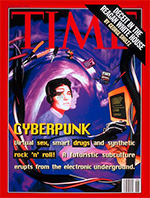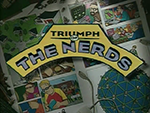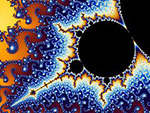 93. 11. Time. Cyberpunk. About to turn 12. Computers were still computers. Not “devices”. That’s when I first got into computers. The three sexy technologies were V.R., A.I., and LISP. “Online” meant America Online. Or CompuServe or Prodigy. “The Internet” hadn’t happened yet because the graphical web browser was just invented. WIRED had just published its very first, bimonthly, issue. That was all twenty-five years ago. WIRED recently acknowledged twenty-five years of WIRED. Google celebrated twenty years of Google. That got me thinking about my own origin story. Writing about what I remember about all these things helps me understand how we got here and where we’re going. I got plenty of other “back in the day” stories. But I promised myself the first one would be about the first personal computer that I actually owned, a Packard Bell 486 SX/33 with 4 megabytes of memory and 340 megabyte hard drive.
93. 11. Time. Cyberpunk. About to turn 12. Computers were still computers. Not “devices”. That’s when I first got into computers. The three sexy technologies were V.R., A.I., and LISP. “Online” meant America Online. Or CompuServe or Prodigy. “The Internet” hadn’t happened yet because the graphical web browser was just invented. WIRED had just published its very first, bimonthly, issue. That was all twenty-five years ago. WIRED recently acknowledged twenty-five years of WIRED. Google celebrated twenty years of Google. That got me thinking about my own origin story. Writing about what I remember about all these things helps me understand how we got here and where we’re going. I got plenty of other “back in the day” stories. But I promised myself the first one would be about the first personal computer that I actually owned, a Packard Bell 486 SX/33 with 4 megabytes of memory and 340 megabyte hard drive.
Apple II
I had used computers before, but not actually owned one. The elementary school I attended had a computer lab, partitioned from a corner of the library, with several tables of Apple II‘s. Each of the four classrooms for each grade level was allocated one hour of time in the computer lab each day for one week per month. When I was in fifth grade, the computer lab got an Apple Macintosh. We were shown how this new type of computer used a mouse that let you do things by pointing and clicking. In addition to all that, my mother taught high school English since I was little. So I would often go up to the school with her on weekends so she could grade papers and work on lesson plans. She’d leave me in that computer lab all day playing Frogger and Q*bert on the Apple II’s.
Almost a Macintosh Color Classic.
My first computer was almost a Macintosh Color Classic, which had just been introduced. Macintosh LC II, upon which Color Classic was based, was effectively the standard for Macintosh in 1993. Color Classic had the insides of an Apple Macintosh LC II and a 10″ color screen , all in the iconic Classic Macintosh form factor. Computer City, the local computer store, had a demo kiosk for Color Classic. The computer store had a webcam setup on the Color Classic, which caught my attention out of the corner of my eye as I walked by it. In 1993, seeing real-time video of yourself in a little window on a computer screen was something magical. The webcam had a long skinny flexible neck and didn’t look like any video camera I had ever seen. And in 1993, they weren’t yet called “webcams”. The Color Classic seemed like it might be a cool first computer to own. However… the problem with Color Classic Macintosh, and all non-PC’s in 1993, was that the overwhelming amount of applications only ran on MS-DOS and Microsoft Windows. I was only twelve and didn’t know much about computers. But what I did know was that I was twelve, didn’t have any money, and owning a Macintosh meant that realistically the only programs I could run were the ones I bought in the store. Therefore, owning any Macintosh just wasn’t going to work.
Packard Bell 486 SX/33
My grandparents were visiting Houston one weekend and, after months of talking about how much I wanted one, finally took me to the department store to get a computer. Computers were still relatively expensive, but with their department store credit card they could finance the purchase. Intel’s Pentium processor had just been released in 1993 and was too new and expensive to even consider. There was also eventually that Pentium floating-point math bug that caused many people, including me, to wait before buying a Pentium. I wanted the minitower 486 DX2/66 with 16 MB of memory. But the payment plan was better on the desktop SX/33. And I was 12 and not in a bargaining position. So the SX/33 is what I got. Once upon a time, getting a new personal computer was a big deal, literally and figuratively. Home computers came in at least two big boxes: one for the computer itself, another for the monitor. There was usually a third big box for a printer. Mine also came with a fourth box of accessories like a surge protector and a floppy disk holder. It occurs to me once in awhile that my grandparents bought me that computer with their credit when I was twelve, made every payment, and never said one word about it to me ever.
So anyway, it was a 486 SX/33 with 4 megabytes of memory and a 340 megabyte hard drive. The “SX” meant the CPU had no math co-processor. In those days, if you wanted your computer to do fancy math then that cost extra. A 486 SX/33 with 4 megabytes of memory was about the bare minimum to run any programs. MS-DOS 6.22 and Microsoft Windows for Workgroups 3.11 came pre-installed. I optimized everything I could to get every bit of performance I could out of that computer. The AUTOEXEC.BAT. The CONFIG.SYS. The WIN.INI. Routinely running DEFRAG on the hard drive. I learned how to optimize it all. And I got Wolfenstein 3D to run reasonably well. And Doom. And everything else I tried to run on that computer.
Multimedia
My new computer had multimedia, which in 1993 meant a sound card and CD-ROM drive. You see, kids, once upon a time computers did not necessarily include the ability to play music or CD’s. Playing music required an expansion card that went inside the computer called a sound card. A company named Creative Labs made a sound card called the Sound Blaster, which back in the day was without any doubt the de facto standard for sound cards. Hence, any sound card worth owning had to be “Sound Blaster compatible” so programs could play sound through it. The sound card in my computer was Sound Blaster compatible.
The CD-ROM’s that came with the computer included Microsoft Bookshelf and Microsoft Encarta, respectively a collection of reference books and multimedia encyclopedia. For their time, Microsoft’s multimedia products, branded as the Microsoft Home series, were consistently high quality because Microsoft could afford to license multimedia content to include with them. Later on, I went to Egghead Software, at one time a major software retailer, and bought Microsoft Cinemania and Microsoft Music Central, which were a movie encyclopedia and music encyclopedia. Microsoft Cinemania included Roger Ebert’s movie reviews, and that CD-ROM is most likely where I discovered my appreciation of cinema.
2400 Baud Data/Fax Modem
My new Packard Bell computer had an internal 2400 baud modem. And Windows 3.1 included Terminal, a black-and-white terminal application. Terminal was effectively just Notepad, only with the ability to use the modem and send/receive files. Computer stores back then typically distributed a computer magazine that was published by the local computer users group, which in Houston is HAL-PC. The local computer users group magazine customarily included a list of bulletin board systems (BBS’s). Books also existed of major BBS’s, sorted by city. Once you logged into a major BBS, you could usually download from there a more up-to-date list of local BBS’s. After a couple months of using Terminal, often all night long, I somehow discovered that Microsoft Works, which came pre-installed on the computer, also included a terminal program. The Microsoft Works terminal application included support for ANSI, which is colored ASCII art. Old school hackers remember with fondness how awesome colored ANSI characters looked on a black background.
Like many people at the time, I was fascinated by bulletin board services because BBS’s were the only way to really use your computer to communicate with other people. I saved up and bought a new external 14.4 Kbps modem from Walmart that connected to my computer’s serial port. When that new modem didn’t work, I learned after much time and frustration one of the first really technical details about my computer’s hardware that I remember to this day. And that was that my computer’s serial port used an older 8250 UART, which meant the external modem wouldn’t work because the modem transferred data faster than the serial port. I also learned that an internal modem would include its own on-board 16550 UART. I exchanged the external modem for an internal modem, which as I recall was a Zoom brand modem. After another very long and frustrating evening, this time learning about COM ports and IRQ settings, I had finally installed my first piece of hardware.
Printer
An Epson dot matrix personal printer was included with the computer. Dot matrix printers were still very common in the early 1990’s. And Epson was kind of the standard for dot matrix printers. Laser printers were still only for big businesses. Inkjet printers, or Canon’s popular bubble jet variation, weren’t yet mainstream. There is nothing interesting to say about my dot matrix printer, except that it was very noisy, like a chainsaw, and the rare occasions that I used that noisy printer gave me an excuse to leave the room for awhile.
Packard Bell
Packard Bell was in the mid 1990’s the most popular brand of personal computers, with a peak market share of 15% of all computers shipped. A website, Packard Bell Planet, even exists to reminisce about this once major brand and the many different models of systems they manufactured. However, by the late 1990’s, the company was out of the personal computer market entirely. What seems to have led to Packard Bell’s fast decline was the rapid commoditization of personal computers. Indeed, Packard Bell was the first, and only, name-brand PC that I ever owned. Every subsequent PC that I owned was put together by me using parts that I purchased separately.
Back In The Day
I have many wonderful memories of that first personal computer and how exciting it was to learn everything about how it worked. The top metal lid stayed off of it more often than not so I could see all the internal parts and configure everything and do various upgrades. Countless hours were spent learning from CD-ROM’s, exploring bulletin board systems, playing the newest games, and, on rare occasion, actually doing homework for school. How fortunate I was to have that opportunity. And absolutely everything was new and exciting. Magic.
 Triumph of the Nerds: The Personal Computer
Triumph of the Nerds: The Personal Computer
 Prizeo Brings Together Celebrities And Charities To Increase Awareness And Raise Money
Prizeo Brings Together Celebrities And Charities To Increase Awareness And Raise Money
 Venture Deals Explains Modern Venture Capital
Venture Deals Explains Modern Venture Capital
 Five Years of Y Combinator Universe
Five Years of Y Combinator Universe






